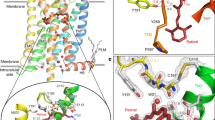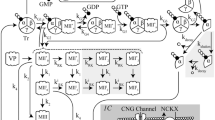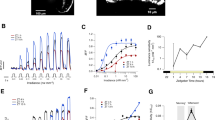Abstract
In photoreceptors, a latency of many milliseconds elapses between the absorption of a light quantum and the occurrence of the late receptor potential, even for strong light stimuli. Surprisingly, this is much longer than the time necessary for conductance changes such as occur in membranes of neurones or muscles, mediated by chemical transmitters. There are several possible explanations for the long photoreceptor latency. (1) It may be due to properties of the visual pigment molecules. For instance, the temporal coincidence of the occurrence of meta-rhodospin II with the receptor signal indicates that the meta I–meta II transition might be the trigger for the electrical response in vertebrate photoreception1. (2) It may be explained by properties of transport processes. Such a time consuming process could be the diffusion of an internal ‘transmitter substance’, which diffuses to a ‘pore’ in the receptor membrane. (3) A third possibility is the time needed to produce and accumulate chemical substances. The light-induced change of the visual pigment molecule might trigger a chemical reaction chain, in which the product of an earlier step triggers the next one. The experiments described here show that a considerable part of the long latency in photoreception is due to processes that are localised at the level of the visual pigment molecule.
This is a preview of subscription content, access via your institution
Access options
Subscribe to this journal
Receive 51 print issues and online access
$199.00 per year
only $3.90 per issue
Buy this article
- Purchase on Springer Link
- Instant access to full article PDF
Prices may be subject to local taxes which are calculated during checkout
Similar content being viewed by others
References
Stieve, H. Nature Rdsch. Stuttg. 27, 45–56 (1974).
Hubbard, R. & St. George, R. C. C. J. gen. Physiol. 41, 501–528 (1958)
Hamdorf, K. in Handbook of Sensory Physiology Vol.VII/6A (ed Autrum, H) 145–224(Springer, Berlin, 1979)
Kirschfeld, K., Feiler, R. & Minke, B. Z. Naturforsch. 33c, 1009–1010 (1978).
Hamdorf, K., Paulsen, R. & Schwemer, J. in Biochemistry and Physiology of Visual Pigments (ed Langer, H) 155–166 (Springer, Berlin, 1973).
Stavenga, D. G., Zantema, A. & Kuiper, J. W. in Biochemistry and Physiology of Visual Pigments (ed Langer, H) 175–180 (Springer, Berlin, 1973).
Muijser, H. & Stavenga, D. G. Biophys. struct. Mech. 5, 187–196 (1979)
Razmjoo, S. & Hamdorf, K. J. comp. Physiol. 105, 279–286 (1976)
Schwemer, J. (in preparation).
Hamdorf, K. & Kirschfeld, K. (in the press).
Hamdorf, K. & Razmjoo, S. Biophys. struct. Mech. 3, 163–170 (1977), 5, 137–161 (1979)
Author information
Authors and Affiliations
Rights and permissions
About this article
Cite this article
Hamdorf, K., Kirschfeld, K. Reversible events in the transduction process of photoreceptors. Nature 283, 859–860 (1980). https://doi.org/10.1038/283859a0
Received:
Accepted:
Issue Date:
DOI: https://doi.org/10.1038/283859a0
This article is cited by
-
Rhodopsin inactivation is a modulated process in Limulus photoreceptors
Nature (1992)
-
Variations in the voltage response to single quanta of light in the photoreceptors of Locusta Migratoria
Biophysics of Structure and Mechanism (1983)
-
Light dependence of oxidative metabolism in fly compound eyes studied in vivo by microspectrofluorometry
Naturwissenschaften (1983)
-
A new model for phototransduction
Nature (1981)
Comments
By submitting a comment you agree to abide by our Terms and Community Guidelines. If you find something abusive or that does not comply with our terms or guidelines please flag it as inappropriate.



